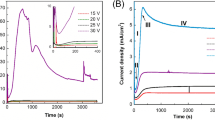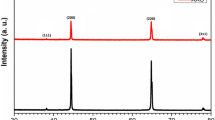Abstract
Alumina membranes were fabricated by anodizing aluminium metal in 0.15 M oxalic acid. The growth kinetics of the porous layer were investigated in the temperature range −1 to 16 °C using linear potential scans up to 70 V. The faradaic efficiencies of metal oxidation and of porous layer formation, determined by applying Faraday's law, were found to be independent of both temperature and electrical charge. SEM analysis of the metal-side and solution-side surfaces revealed different morphologies. After dissolution of the barrier layer in phosphoric acid, the metal-side surface showed circular pores whose size of about 90 nm was found to be uniform and independent of temperature. The pore population was also practically independent of temperature and a value of about 4 × 1013 pores m−2 was determined. On the solution-side surface the presence of a deposit partially occluding the mouths of pores was observed. This coating could be removed by chemical etching in NaOH or thermal treatment at 870 °C, where decomposition of oxalate occurs. This supports the hypothesis that the deposit consists of an aluminium salt containing oxalate anions precipitated from the solution. The results show that it is possible to control the morphological characteristics of the anodic alumina membranes by careful choice of experimental conditions.
Similar content being viewed by others
References
J. Corona and J. Santamaria, Catal. Today 51 (1999) 377.
A. Julbe, D. Farrugsen and C. Guizard, J. Membr. Sci. 181 (2001)3.
F.M. Vichi, M.T. Colomer and M.A. Anderson, Electrochem. Solid State Lett. 2 (1999) 313.
N. Wara Andro., F. Francis and B.V. Velamakanni, AIChE J. 43 (11A) (1997) 2878.
Li Shi and N.-B. Wong, J. Mater. Res. 14 (1999) 3599.
M. Pan, C. Cooper, Y.S. Lin and G.Y. Meng, J. Membr. Sci. 158 (1999) 235.
R.C. Furneaux, W.R. Rigby and A.P. Davidson, Nature 337 (1989) 147.
A. Larbot, J.P. Fabre, C. Guizard and L. Cot, J. Membr. Sci. 39 (1988) 302.
T. Okubo, M. Watanabe, K. Kusakabe and S. Morooka, J.Membr. Sci. 25 (1990) 4822.
H. Masuda and K. Fukuda, Science 268 (1995) 1466.
G. Che, B.B. Lakshmi, Ellen R. Fisher and C.R. Martin, Nature 393 (1988) 346.
T.A. Hanaoka, A. Heilmann, M. Kroll, H.P. Kormann, T. Sawitowski, G. Schmid, P. Jutzi, A. Klipp, U. Kreibig and R. Neuendorf, Appl. Organometal. Chem. 12 (1998) 367.
G. Shi, C.M. Mo, W.L. Cai and L.D. Zhang, Solid State Commun. 115 (2000) 253.
N.V. Gaponenko, O.V. Sergeev, E.A. Stepanova, V.M. Parkun, A.V. Mudry, H. Gnaser, J. Misiewicz, R. Heiderho., L.J. Balk and G.E. Thompson, J. Electrochem. Soc. 148 (2001) H13.
F. Muller, A-D. Muller, M. Kroll and G. Schmid, Appl. Surf. Sci. 171 (2001) 125.
Y. Lei, L.D. Zhang, G.W. Meng, G.H. Li, X.Y. Zhang, C.H. Liang, W. Chen and S.X. Wang, Appl. Phys. Lett. 78 (2001) 1.
J.W. Diggle, T.C. Downie and C.W. Goulding, Chem. Rev. 69 (1969) 370.
Y. Xu, G.E. Thompson and G.C. Wood, Electrochim. Acta 27 (1982) 1623.
G.E. Thompson, Y. Xu, P. Skeldon, K. Shimizu, S.H. Han and G.C. Wood, Phil. Mag. 55 (1987) 651.
O. Jessensky, F. Muller and U. Gosele, J. Electrochem. Soc. 145 (1998) 3735.
P. Bocchetta, C. Sunseri, E. Drioli, A. Regina, S. Piazza and F. Di Quarto, in preparation.
F. Di Quarto, C. Gentile, S. Piazza and C. Sunseri, J. Electrochem.Soc. 138 (1991) 1856.
A. Despic and V.P. Parkhutick, in J.O.'M Bockris, R.E. White and B.E. Conway (Ed), Modern Aspects of Electrochemistry, No. 20, (Plenum Press, New York, 1989) p. 401.
J.P. O'sullivan and G.C. Wood, Proc. R. Soc. Lond., Ser. A 317 (1970) 511.
J. Siejka and C. Ortega, J. Electrochem. Soc. 124 (1977) 883.
A.T. Shawaqfeh and R.E. Baltus, J. Electrochem. Soc. 145 (1998) 2699.
Y. Liu, R.S. Alwitt and K. Shimizu, J. Electrochem Soc. 147 (2000) 1382.
C.-W. Lee, H.-S. Kang, Y.-H. Chang and Y.-M. Hahm, Korean J.Chem. Eng. 17 (2000) 266.
JCPDS International Centre for Difraction Data: file No. 16-394 (Philadelphia, 1974); file No. 23-1009 (Philadelphia, 1983). 985
Author information
Authors and Affiliations
Corresponding author
Rights and permissions
About this article
Cite this article
Bocchetta, P., Sunseri, C., Bottino, A. et al. Asymmetric alumina membranes electrochemically formed in oxalic acid solution. Journal of Applied Electrochemistry 32, 977–985 (2002). https://doi.org/10.1023/A:1020960719245
Issue Date:
DOI: https://doi.org/10.1023/A:1020960719245




